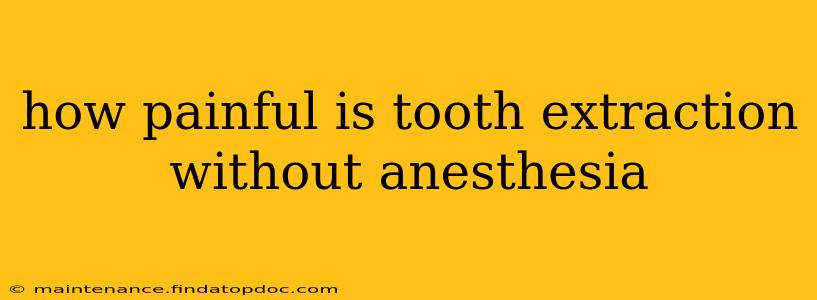The pain of a tooth extraction without anesthesia is intense and highly variable, depending on several factors. It's not something anyone should willingly experience, and modern dentistry makes it completely unnecessary. However, understanding the potential pain involved can help illustrate the importance of proper dental care and the benefits of anesthesia.
While there's no precise numerical scale to measure the pain, many describe it as excruciating, bordering on unbearable. The experience involves a complex interplay of several pain sensations:
-
Sharp, piercing pain: This is the initial pain felt as the dentist applies force to remove the tooth. The pressure on the tooth's nerve endings and the tearing of periodontal ligaments cause this acute pain.
-
Crushing pressure: As the tooth is loosened and extracted, you'll feel intense pressure. This pressure is often described as being far more uncomfortable than a simple sharp pain.
-
Bone and soft tissue trauma: Extracting a tooth inevitably involves some damage to the surrounding bone and gum tissue. This trauma contributes significantly to the overall pain experience.
-
Post-extraction pain: Even after the tooth is removed, you'll experience significant pain as the extraction site heals. This post-operative pain can be intense and can last for several days.
What Factors Influence the Pain Level?
Several factors influence how painful a tooth extraction is without anesthesia:
-
Type of tooth: Extracting molars, with their larger roots and more complex anatomy, is generally more painful than extracting incisors or canines.
-
Condition of the tooth: A tooth that is already infected or severely decayed may cause more pain during extraction because the infection itself is already causing inflammation and sensitivity.
-
Skill of the dentist: An experienced and skilled dentist will perform the procedure more efficiently and with less trauma, potentially minimizing the pain. However, this doesn't eliminate the excruciating pain associated with the procedure.
-
Individual pain tolerance: People naturally have different pain thresholds and coping mechanisms. What one person considers unbearable, another might find tolerable (though still extremely unpleasant).
What Happens During a Tooth Extraction Without Anesthesia?
The extraction process itself is brutal without anesthesia. The dentist will need to use instruments to loosen the tooth from its socket, a process that causes intense pain, pressure, and potential trauma. The process will likely be protracted because the patient will have an extreme reaction to the pain and pressure.
Is There a Safer Alternative?
Absolutely! Modern dentistry offers various forms of anesthesia, from local anesthesia that numbs the area to more advanced techniques that completely sedate the patient. There is no reason to undergo a tooth extraction without proper anesthesia.
Why is Anesthesia Crucial for Tooth Extraction?
The primary reason anesthesia is crucial is to eliminate pain and discomfort. This allows the dentist to perform the procedure efficiently and accurately, reducing the risk of complications. More importantly, it allows the patient a comfortable and trauma-free experience.
How to Manage Pain After a Tooth Extraction (With Anesthesia)?
Even with anesthesia, some discomfort is normal after a tooth extraction. Your dentist will likely prescribe pain medication and provide aftercare instructions to help manage the pain and promote healing.
In conclusion, undergoing a tooth extraction without anesthesia is incredibly painful and should never be considered a viable option. Modern dentistry provides safe and effective anesthesia methods to make the procedure as comfortable as possible. Always consult with a dentist for any dental concerns.
